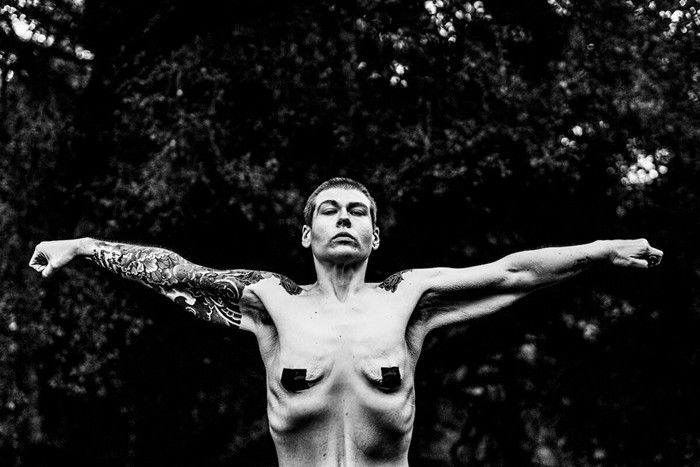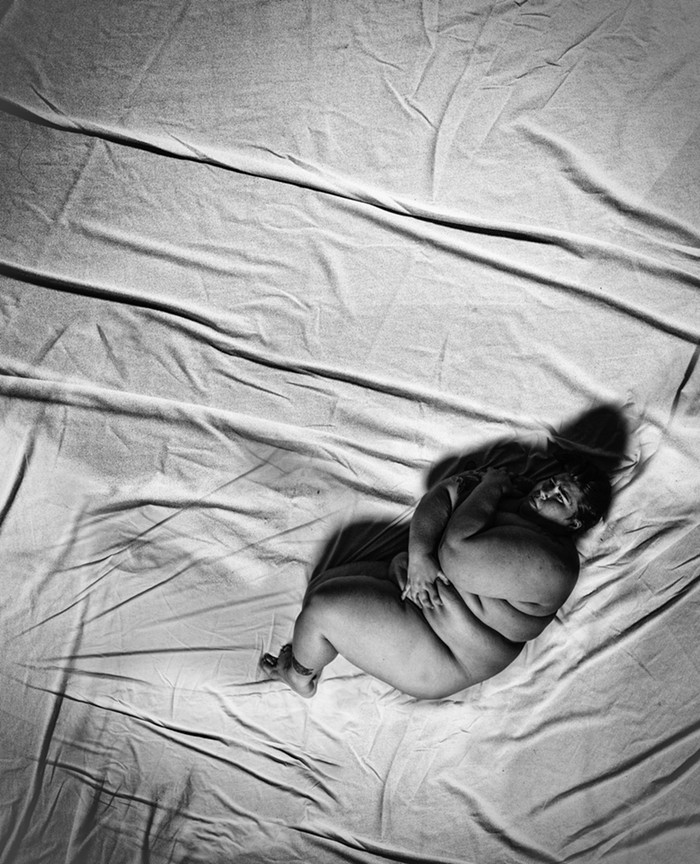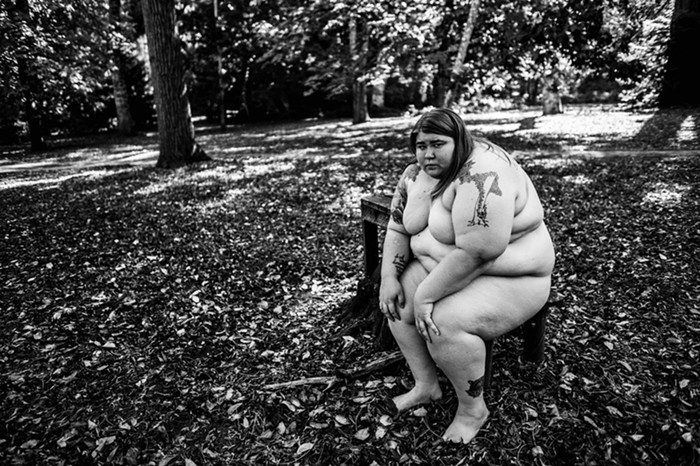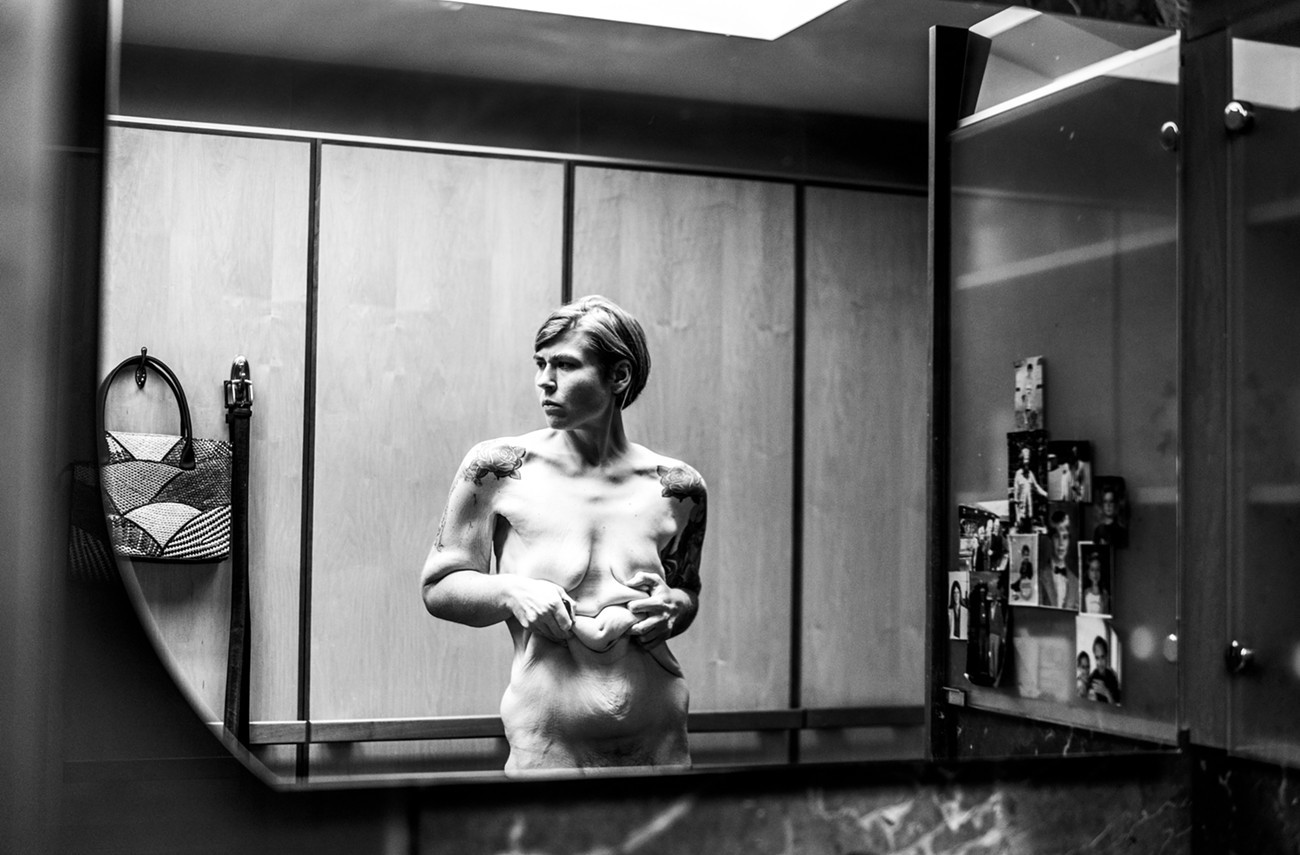Sam Geballe (they/them) is a San Francisco Bay Area trans/genderqueer artist who has been developing a series of self portraits since 2013. The series began as a self-portraiture concept, but developed into something more as the artist underwent gastric bypass surgery and documented their experience. In these incredibly creative and graphically striking photographs, we are welcomed into a very personal journey of an evolving body, charged with emotion and sincerity. In our interview, we talk about body image, memory, gender, trauma, and healing.
This project, Self-Untitled, is such a beautiful confrontation of body shame and a practice in self-acceptance. I’d love to hear about your initial steps in conceiving this work, and how it’s evolved.
I started this work after I was academically suspended from Art Center College of Design. I was having great trouble with my mental health and, to be frank, I had an even more difficult time fitting in and managing school as a very big person. It was exhausting. Before Art Center, I had dropped out of a number of classes because of my size. I often didn’t fit in desks and was in constant pain from carrying equipment, let alone the weight of my own body.

I had to wait a year before I could reapply to school, and it was important for the photo department to see that I was still trying to better myself outside of that environment. I focused on portraiture, but felt uncomfortable asking people for their time. I decided on self-portraits because I’m always available. I thought it would be easier, but it wasn’t. Self-portraiture was extremely painful at first (it still can be), as I had dissociated from what I looked like, and it forced me to get real about where my life was at the time.
I remember crying during most of the class where I presented my first nude self-portrait. I photographed what was happening in my life, and a major part of my life was mitigating my symptoms of mental illness and grappling with the consequences of my weight, eating disorder, and trauma.
At some point, I woke up to [the] physical complications I was having because of my weight. I’m not being hyperbolic when I say I was dying in my sleep. I saw a number of doctors who believed it was more dangerous for me not to have gastric bypass. I spent over a year preparing for that surgery, so my work shifted into processing and documenting what waiting was like. I was constantly afraid I was about to die, angry at how truly brutal people were/are to folks who are fat, and despised myself for the food I ate and weight I gained.

People don’t usually just wake up one day and just decide to be brave, what did it take for you to get comfortable sharing such personal images?
I think if I knew where my photos would have ended up, I may have never shown the work. I still have a hard time understanding why anyone cares about my photos. I have never seen it as particularly brave. I guess every time I left my home when I was fat, it did take a certain level of bravery. People—strangers, acquaintances, even friends—were very cruel at times. That was my experience since early childhood.

You’ve talked about how black-and-white portraiture offers a lot of opportunities to craft a more calculated presentation of your body (shadow, focal depth, etc.). How consciously are you balancing the opposing forces of facing your vulnerability, yet exercising control over the presentation?
I’m attracted to polarizing sunlight and shadows, because I find it beautiful and it also offers self-protection. Dealing with harsh light and shadow allows black and white to become a subject unto itself.
In order to keep doing this work, I have had to use black-and-white extremes when I don’t want to see myself. There are days when I know that if my chest is visible, it will be a recipe for tearing my self-esteem down. I have had to learn how to navigate urges to self-harm through self-portraiture. Now, I more quickly recognize when I’m being unkind. Sometimes I stop and sometimes I choose to do damage.
For example, I will make the decision to blow out the highlights that give definition to my stomach, because I’m not feeling great about my excess skin. I might be body checking. Body checking can fuel my eating disorder, and it gives a false sense of security in visualizing if I’m “good enough” for the day. Most of the time, my perception is inaccurate, and a moving target.

The idea of self-harm through self-portraiture is intense. Are there images that are too painful to show?
Yes, being trans has added a layer of difficulty when interacting with older work. It is easier for me to see pictures of myself big and appearing AFAB (Assigned Female at Birth), because I have depersonalized the images as self-portraits. I don’t automatically register them as myself. Post-surgery, late 2015 on, is harder for me to separate from. The nudes can be uncomfortable and stir up gender dysphoria. I am particularly dysphoric about my chest, and there are several images where that was the subject. They become too painful to show. It also took time for me to realize that I did not need to show them, and I have agency to make that choice. My mental health is more important.

In your artist talk with Brittney Cathey-Adams at Blue Sky Gallery, you mentioned that you’ve always had some degree of body dysmorphia. Is it getting easier to shoot and edit now that you’re in a smaller body?
No, and it may be even harder. I treated myself very poorly when I was big because I hated my body and existing within it. I still don’t like my body, to a lesser degree than before, but now I have an overwhelming fear of regaining weight and going back. That fear has been a source of over-control and it extends into self portraiture. Photography can be a liar and my eyes usually are too.
You manage to make a digital medium look wonderfully analog. Can you talk about your gear and/or reveal any of your processing techniques?
My favorite camera has been the Sony A99II, which was discontinued. For settings, I turn the ISO up, way up. Bring on the noise. Digital black and white can make noise look like grain. Digital color doesn’t usually afford that luxury. Typically, even in broad daylight, I shoot at ISO 1200-6400. I also shoot wide open. Unless I’m having trouble with focusing, my aperture sits between f1.4–f2.8. I almost always have a tripod, and I use a wireless shutter release. Adobe Lightroom is my post-processing software of choice, but I try to get most things done in-camera.

What’s next for 2023?
Last year, I spent many months putting my first book together. I made it in a workshop held by Nord Photography Workshops that was facilitated by Elizabeth Avedon. Her knowledge is vast and she is attentive to detail. I initially took the class thinking I’d practice making a book. I pushed myself to learn InDesign, and I can’t believe I made something that I truly love.
I’m in the process of handwriting my story. I find that when I write by hand, I am much more honest. I also intend on making a longer film that includes scoring the music, editing, and sequencing, but I need to build up my filmmaking skills in order to make it happen. I do have ideas for other projects within Self-Untitled, and I’m interested enough to find a path toward having them realized. Something I found out after surgery is that I love learning, and I am an incredibly curious person.

Closing thoughts/advice for anyone struggling with body image?
My advice to anyone struggling is that there is support out there. You don’t need to do it alone. Support groups of people who have similarly struggled have been crucial in working towards my own healing. Being heard and acknowledged is unparalleled. There is something special that happens in a room (whether virtual or in-person) where others nod their heads with compassion and understanding, but also call me out (gently and with care/kitten gloves) when they see it.
Thank you for asking me to speak. I appreciate it and your willingness to listen.
Find more of Sam’s work at samgeballe.com and follow @selfuntitledsam.


















